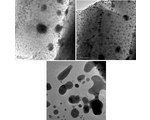Ask for a reprint
email :
* Give your email
2011
ACL
|
O.Veron, J.P.Blondeau, D.De Sousa Meneses, C.Andreazza Vignolle, 'Structural Changes of Ag+–Na+ Annealed Ion-Exchanged Silicate Glasses Scanning Electron Microscopy, Far-Infrared Reflectivity, UV-Visible Absorption, and TEM Investigation', Plasmonics 6 137-148 (2011) doi:10.1007/s11468-010-9179-y
The effect of silver ionic exchange on the glass structure in a molten bath at 350 °C was presented in a previous paper Catan et al. [1] (J NonCryst Solids 354:1026– 1031, 2008). In this paper, the experiment is driven for a temperature near 310 °C, the eutectic of a 10% AgNO3– NaNO3 molten salt. The various exchanged silicate glasses are further annealed to obtain silver particles in the matrix. Infrared spectroscopy combined with UV/Visible spectroscopy and scanning electron microscopy analysis allowed to correlate the silver-ion penetration and particle formation with the degree of polymerisation of the silicate network. The previous results have demonstrated an insertion of silver ions in the glass structure that is about 10% higher than the departure of sodium ions. Infrared results obtained after ion exchange have proved that local alterations lead to a higher degree of depolymerisation of the silicate network. Here, the annealing of the samples promotes the formation of silver nanoparticles, the infrared measurements prove that the aggregation is correlated to a repolymerisation of the silicate network. Transmission electron microscopy (TEM) is used to evaluate the distribution size of the silver particles after annealing and to correlate it to the evolution of the absorption curves. The TEM observations prove that the particle are below the incident wavelength but shape factor could lead to scattering contribution when particle growths and to absorption spectra evolution.
|

|